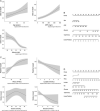Predicting necrotising soft tissue infections in people who inject drugs: poor performance of the Laboratory Risk Indicator for Necrotising Fasciitis score and development of a novel clinical predictive nomogram in a retrospective cohort with internal validation
- PMID: 37042577
- PMCID: PMC10389200
- DOI: 10.1097/JS9.0000000000000367
Predicting necrotising soft tissue infections in people who inject drugs: poor performance of the Laboratory Risk Indicator for Necrotising Fasciitis score and development of a novel clinical predictive nomogram in a retrospective cohort with internal validation
Abstract
Introduction: Necrotising soft tissue infections (NSTI) can threaten life and limb. Early identification and urgent surgical debridement are key for improved outcomes. NSTI can be insidious. Scoring systems, like the Laboratory Risk Indicator for Necrotising Fasciitis (LRINEC), exist to aid diagnosis. People who inject drugs (PWID) are high risk for NSTI. This study aimed to assess the utility of the LRINEC in PWID with lower limb infections and develop a predictive nomogram.
Methods: A retrospective database of all hospital admissions due to limb-related complications secondary to injecting drug use between December 2011 and December 2020 was compiled through discharge codes and a prospectively maintained Vascular Surgery database. All lower limb infections were extracted from this database, dichotomised by NSTI and non-NSTI with the LRINEC applied. Specialty management times were evaluated. Statistical analyses involved: chi-square; Analysis of "variance"; Kaplan-Meier, and receiver operating characteristic curves. Nomograms were developed to facilitate diagnosis and predict survival.
Results: There were 557 admissions for 378 patients, with 124 (22.3%; 111 patients) NSTI. Time from admission to: theatre and computed tomography imaging respectively varied significantly between specialties ( P =0.001). Surgical specialties were faster than medical ( P =0.001). Vascular surgery received the most admissions and had the quickest time to theatre. During follow-up there were 79 (20.9%) deaths: 27 (24.3%) NSTI and 52 (19.5%) non-NSTI. LRINEC ≥6 had a positive predictive value of 33.3% and sensitivity of 74% for NSTI. LRINEC <6 had a negative predictive value of 90.7% and specificity of 63.2% for non-NSTI. Area under the curve was 0.697 (95% CI: 0.615-0.778). Nomogram models found age, C-reactive protein, and non-linear albumin to be significant predictors of NSTI, with age, white cell count, sodium, creatinine, C-reactive protein, and albumin being significant in predicting survival on discharge.
Conclusion: There was reduced performance of the LRINEC in this PWID cohort. Diagnosis may be enhanced through use of this predictive nomogram.
Copyright © 2023 The Author(s). Published by Wolters Kluwer Health, Inc.
Conflict of interest statement
The authors declare that they have no financial conflict of interest with regard to the content of this report.
Sponsorships or competing interests that may be relevant to content are disclosed at the end of this article.
Figures





References
-
- Goh T, Goh LG, Ang CH, et al. . Early diagnosis of necrotizing fasciitis. Br J Surg 2014;101:e119–e125. - PubMed
-
- Stevens DL, AE Bryant. Necrotizing soft-tissue infections. N Engl J Med 2017;337:2253–2265. - PubMed
-
- Wong CH, Chang HC, Pasupathy S, et al. . Necrotizing fasciitis: clinical presentation, microbiology, and determinants of mortality. J Bone Joint Surg Am 2003;85 8:1454–1460. - PubMed
MeSH terms
Substances
LinkOut - more resources
Full Text Sources
Research Materials

